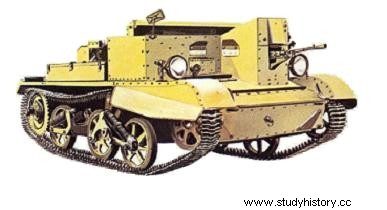
Series Carden-Loyd, Bren Carrier, T 16 (in USA)
Type :infantry tankette.
Crew :4-5 men.
Armament :a Bren light machine gun or a Boys anti-tank rifle.
Armour :12mm.
Dimensions:
length r 3.75 m;
width :2.10 m;
height :1.60 m.
Weight in combat order :4 t.
Engine :Ford 8 cyl. in line, developing 85 hp at 2,800 rpm.
Performance:
speed :51 km/h;
autonomy :256km;
obstacle vertical:0.711 m;
clean cut :1.6 m;
slope :60%.
Service time :developed in 1939 from a long line of infantry transporters, all of similar dimensions; some 35,000 units made in the UK during World War II, 5,600 in Australia, 520 in New Zealand and over 29,000 in Canada; nearly 14,000 also produced in the United States under the name of T 16. Production ended in 1945 but the vehicle remained in service until the early 1950s. The variants are so numerous that their classification alone would require a whole study. /P>
Today, the memory of the Bren carrier is fading a little in the minds of the infantrymen but, in its time, this particular material held a great place in the heart of the troop.
Derived from the Carden-Loyd series of the 1930s, it actually dated back to the 1921 Ammunition Carrier, a tracked armored vehicle designed to deliver 18-pound shells over terrain that the opposing defense made it inaccessible to the Army Service Corps horse-drawn train.
On a more modest scale, the first <, universal tankette>, had the same mission:to ensure the transport and the protection of the infantry under a barrage of portable weapons and more especially - from where the familiar name of Carrier Bren — the transport of a Bren light machine gun and its servants.
In fact, only one model of the tankette bore the official designation of Carrier-Bren but the users were going to give this name to all the range, regardless of the specific mission. The hull was a simple steel box housing a Ford V-8 engine in its center. The driver was seated in the front side by side with the gunner, on either side of a partition where the radiator was housed, which, engine running, made any conversation between the two men practically impossible.
Behind, flanking the engine and the gearbox, there were two compartments in the shape of a coffin intended for the storage of the main cargo which could be represented also by men or by men and their heavy weapon supplied. In some cases, the weapon was mounted on the cover of the engine compartment and could go into action without the crew having to disembark. Most tankettes in service provided infantry support by transporting mortars, medium-caliber machine guns or pulling anti-tank guns. Most often a booster vehicle resupplied ammunition.
The undercarriage, a development of the Vickers and Loyd series, had three road wheels on each side, two of which were coupled and one single wheel, all suspended by coil springs according to the system introduced by the Horstmann company. All the twin wheels of the same bogie were placed on a shaft crossing the bodywork, and removable in order to be able to tension the track and allow smooth turning without changing the rolling speed. The sprocket was located at the rear and connected to a normal Ford differential. Sharp turns were made using simple brakes and steering by means of a steering wheel:weakly applied, this brought the tension of the track while a movement of greater amplitude actuated the steering brakes.
Truck-like controls kept specialized training to a minimum. The multitude of possible missions for the tankette caused a certain diversity in the procedures of equipment and loading. In 1945, most of the vehicles carried without apparent difficulty a weight much higher than the initial estimates. In daily practice, a road wheel for emergency repairs took place on the glacis, and a large camouflage net was attached to the back. In winter, some units covered their vehicles with a removable tarp.
